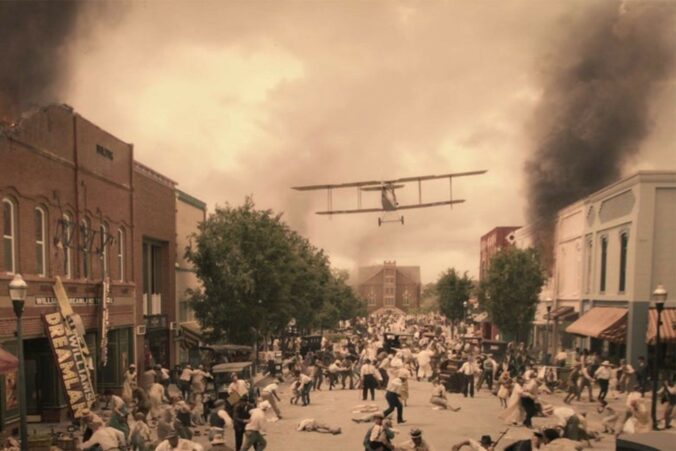If all you know about the Tulsa Race Massacre is the re-creations of the attack featured in HBO series like Watchmen and Lovecraft Country, prepare yourself for a serious education over the next few weeks.
Monday marks the 100th anniversary for one of the worst acts of racial violence in American history, the Tulsa Race Massacre. Back in 1921, a mob of white people tore down and burned the Greenwood district of Tulsa, Okla. — a segregated part of the city so prosperous and bustling, it was known as Black Wall Street.
According to some historians, over 1,200 homes and buildings were destroyed by the violence, killing between 100 and 300 people. But thanks to white-dominated power structures in the city of Tulsa and state of Oklahoma, news about the massacre was wiped from many official sources for decades (several fans of Watchmen and Lovecraft Country have told me they had never heard of the massacre before these fictional TV shows dramatized the attack during their episodes last year and in 2019).
These are a wide array of documentary films and TV programs aimed at reminding Americans just how deadly unchecked racism can be.
Here are capsule reviews of three powerful films I found most compelling, from The History Channel, CNN and PBS. Watch at least one of them to learn the kind of American history that should have been taught in classrooms and from schoolbooks nationwide for the past 100 years.
Tulsa Burning: The 1921 Race Massacre, airing on The History Channel (May 30)
This is easily the most cinematic of the three documentaries — small surprise, given its pedigree. Co-directed and executive produced by Emmy-winner Stanley Nelson (Freedom Riders), the film is also executive produced by NBA superstar Russell Westbrook, featuring original music from Branford Marsalis. The story begins with words from Rev. Turner’s bullhorn, unspooling into an epic tale of how Black people migrated to Tulsa and built a bustling, successful business district, keeping dollars in the Black community until two days of mob violence destroyed it all. Archival footage of Greenwood, looking impossibly clear and vivid, appears next to photos and inspired commentary from experts like The New York Times columnist Brent Staples and historian Scott Ellsworth. The result is a detailed, evocative story of the massacre and its connection to modern Tulsa, including a renewed, modern effort to find mass graves. This compelling film is also paired with a six-part podcast produced by The History Channel and WNYC Studios in collaboration with KOSU public radio in Oklahoma, dubbed Blindspot: Tulsa Burning.
Dreamland: The Burning of Black Wall Street, debuting on CNN and streaming on HBO Max (May 31)
This film features another NBA star, LeBron James, as an executive producer, adding evocative animation sequences to newsreel footage and archival photos to re-create scenes from 100 years ago. CNN’s film traces a history similar to Tulsa Burning, bringing cameras to modern Tulsa’s modest Greenwood district to show off small businesses continuing a historic legacy, as detailed maps display how much the area has shrunk from its successful heights 100 years ago. While Black people in 1921 enjoyed a community one expert says was like Bourbon Street, Harlem and Washington D.C. rolled into one, racist and resentful white Tulsans used pejorative phrases like “Little Africa” and “N*****town” to describe the area. Named for a popular theater in the Greenwood district, Dreamland uses actors to read powerful quotes from politicians and publications of the time, including Tulsa’s mayor during the massacre, T. D. Evans, who blamed the Black victims of the attack for “instigating” a “negro uprising.” Rev. Turner also shows up here, pointing out areas in his church’s basement where victims huddled while the top floors of the church were destroyed. “I believe there is no expiration date on morality,” the pastor says, explaining why he remains an aggressive advocate for uncovering the mass graves and finding justice for the city’s Black community.
Tulsa: The Fire and the Forgotten, premiering on PBS (May 31)
For a more personal story, consider this film, focused on the work of longtime Washington Post journalist DeNeen L. Brown, whose reporting on the Tulsa Race Massacre has spread word about the history of the attack. Brown, whose father lives in Tulsa and is a pastor at a Baptist church in town, is shown interviewing descendants of attack victims and experts leading the modern effort to find and exhume unmarked graves. She also serves as a producer on the film, alongside human rights investigator Eric Stover, who is featured in interviews as an expert source; the film is narrated by NPR’s own Michel Martin, weekend host of All Things Considered. Viewers learn of failed efforts to sue the government for failing to protect the community — descendants were told the statute of limitations had passed. And the film shows how graphic photos of the destruction were turned into postcards and distributed by some white people. Here, the search for evidence of unmarked graves is presented as a bit of a cliffhanger, as experts work to identify likely areas for the remains, hoping to prove they are the discarded bodies of massacre victims.
